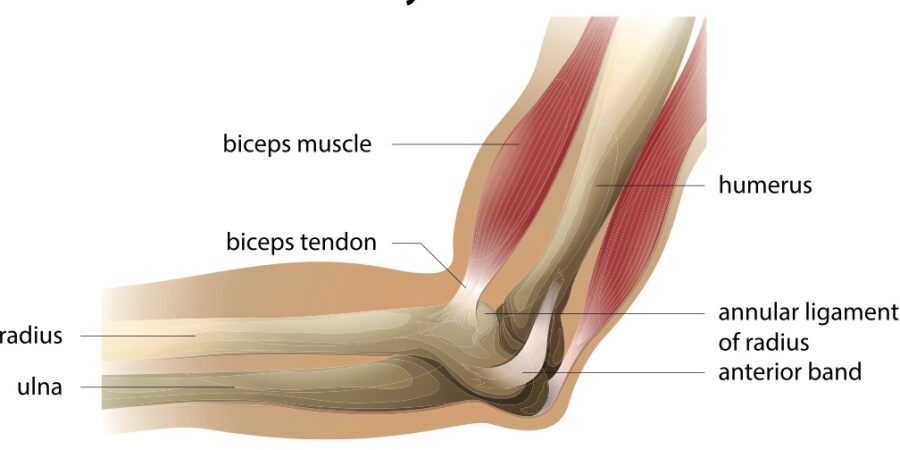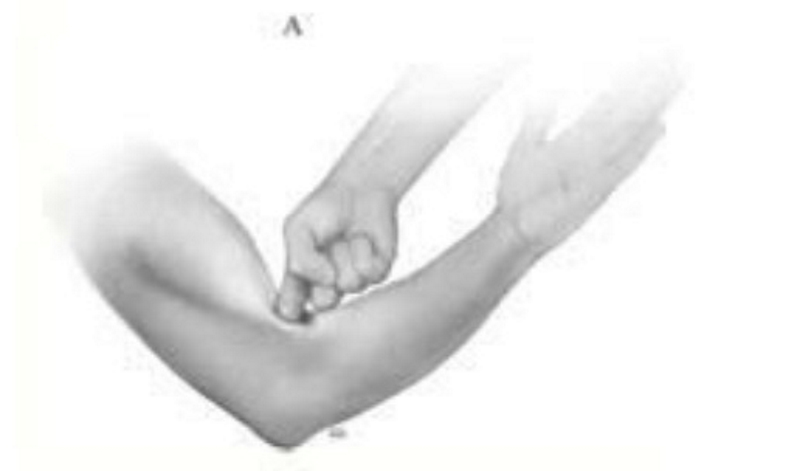One of the more common gym injuries is bicep tendonitis elbow. Generally, too much exercise or overload leads to swelling of the biceps tendon and distal biceps tendonitis. So, how does pain in the biceps tendon at the elbow present, and what can you do about it?
What is biceps tendonitis elbow?
The biceps muscle is found at the front of the upper arm. As the muscle passes over the elbow, it forms a strong tendon that attaches to the radius. The biceps muscle has two functions: it bends the elbow and turns the wrist outwards. This muscle is essential in repeated movements such as biceps curls, manual labor, or screwdriver use.
Overloading the tendon leads to pain and swelling at the biceps tendon’s attachment to the elbow, which is often called distal biceps tendonitis.

How do you know you have distal biceps tendonitis?
Heavy pulling exercises such as biceps curls or pull-ups on a bar can stress the lower biceps tendon. This stress leads to swelling of the tendon, known as distal bicep tendonitis or lower bicep tendon pain.
Common symptoms of lower bicep tendon pain include:
- Sharp pain or a dull ache at the front of the elbow or just below the elbow, often described as lower bicep tendon pain
- Pain and weakness after pulling exercises or repeated manual work
- Tender spots in the elbow just below the biceps
Tennis elbow or bicep tendonitis: How can you tell?
Biceps tendonitis is different from tennis elbow. Other tendon injuries occur on the inside and outside of the elbow. Often, it can be difficult to tell the difference between these tendon injuries. Generally, careful examination is necessary to determine the cause of elbow pain. Usually, tennis elbow causes pain at the tip of the outside of the elbow, whereas pain from lower biceps tendonitis is more in the center. This is where ultrasound or MRI may help put you on the correct diagnosis and treatment path.
Can you rupture your distal biceps tendon?
Yes, but it is uncommon to cause a bicep tendon tear at the elbow. Complete ruptures occur after trauma, such as a tackle during rugby. Often, players report a pop or crack followed by severe pain and weakness. The tear occurs at the gym when picking up a heavy barbell with the elbow bent.
Usually, the biceps muscle changes shape and looks like ‘Popeye’s biceps.’ Bruising and swelling follow after a few days. Sometimes, the biceps tendon only partially ruptures and can look like lower biceps tendonitis. As treatment changes, spotting a bicep tendon tear at the elbow from tendonitis is essential.

Generally, we carefully examine anyone we suspect has a biceps tendon tear at the elbow. The hook test is often used to determine whether the biceps tendon is torn. We use our index finger to hook the biceps tendon near the elbow. The hook test is positive if we can’t feel the tendon over our finger. This means the tendon is torn.
Distal bicep tendonitis treatment
Overall, most cases of lower bicep tendonitis will settle with simple treatments. A short course of anti-inflammatories such as ibuprofen will help with biceps pain near the elbow. It is essential to change or modify your gym exercises. For example, switching from biceps to hammer curls or pull-ups to lat pulldowns usually helps. Also, changing the wrist grip for pulling exercises from palm down to palm up is often better. Strengthening the biceps muscle, starting at a lighter weight and increasing slowly and progressively, aids in lower biceps pain relief.
What happens if exercise fails for biceps tendonitis elbow?
In complex cases, we consider injections to reduce tendon swelling and stimulate healing. If you get stuck, ultrasound-guided distal biceps tendon injection is an option.
Dr. Masci has written a scientific paper summarising injections for tendonitis. We can discuss a few options for distal bicep tendonitis with you.
Firstly, although cortisone is a potent anti-inflammatory, we must be careful when using cortisone for the distal biceps tendon. There is evidence that cortisone injections weaken tendons, leading to rupture. Therefore, we must do cortisone injections with ultrasound to avoid injecting directly into the distal biceps tendon. Moreover, we should prevent the injection of cortisone into biceps tendon tears.
Secondly, an injection called’ needle tenotomy’ is a less risky and potentially more practical option. Using a numbing solution, we pass a small needle through the biceps tendon multiple times. We think this needling causes micro-injuries leading to tendon healing and remodeling.
Finally, we use platelet-rich plasma (PRP) injections in some cases. PRP is obtained from whole blood taken from a vein in the elbow. We spin the blood in a machine so the cells move to the bottom. The plasma on the top contains smaller cells called platelets, which have growth factors. We inject this plasma into and around the tendon to stimulate healing.
Partial tear biceps tendon: How to treat it?
A full-thickness tear of the biceps tendon leads to a significant loss of power and needs surgery. Generally, surgery results are much better if we repair them within three weeks of the injury.
A partial biceps tendon tear is a little more problematic.
Sometimes, a scan describes the tendon as ‘partially torn.’ But in fact, there is a complete tear of one of the heads of the tendon – either the short or long head. In these cases, we recommend a repair. However, some surgeons suggest conservative treatment with rehab and/or injeciton therapy such as PRP injection before considering a repair. In an actual partial tear, the treatment is similar to tendonitis.
Final word from Sportdoctorlondon about distal bicep tendonitis
Distal bicep tendonitis is a common cause of elbow pain in gym-goers. Simple treatments can reduce pain and improve mobility. If these simple steps are ineffective, other treatments such as cortisone injections, needle tenotomy, or PRP injections are possible.



Hi dear Dr.
I have a partial distal biceps tear, please guide me how to treat it without surgery, I am coach of powerlifting and need my power , I have studied about kinds of distal biceps tear and i know that the best way is surgery ,but I want to treat it without surgery with the help of you and sport , I would be gradeful to hear from you, thank you MN
Hi, It’s hard to give you specifics without seeing you and your images. You need a combination of slow resistance +/- injections – needle fenestration or PRP.
What is the expected recovery time for a partial tear? Would it speed up with prp therapy
Generally, partial tears take longer to heal. As a general rule, 3-4 months.
We’re not sure if PRP changes or accelerates recovery.
LM
Hello I’m John, I recently injured my distal bicep tendon. And was wondering if that causes swelling of veins in the area
probably not.
Thank you so much for your informative blog. I’ve had elbow pain for 3 months and my doctor has been unable to diagnose it. I’ll now go to her with information from your blog. Thank you.
Thanks, James for your comment. Good luck with getting over your injury.
I’ve had the distal bicep tendinitis for about 4 years. I can work through it at the gym except pull-ups. Could this be a life long injury I’ll live with? And could this lead to a year if I continue to work through the pain. I’m 32 yo male.
unlikely to tear unless 1) you have a cortisone injection or 2) use anabolic steroid (although the link between anabolics and tendon tears is tenuous). low-level ‘stable’ pain is ok. See blog on tendon pain and exercise
https://sportdoctorlondon.com/tendonitis-specialist/
Thank you for your blog, I like so many find your information very helpful..
I have had distal bicep tendinitis from progressively doing more and more pull ups. I am stretching my wrist out in a concentric and essentric movement without any major benefits.
However, would it help if I strapped my lower bicep tendon to relieve the pain?
Hi Hedley,
I suggest avoiding pull-ups and changing to lighter lat pull-downs – so you can control the load more. I’d also perform lighter isolated biceps curls to add load to your biceps tendon. I don’t find straps to the elbow particularly effective.
LM
Thank you so much for this insightful information. Recently got back into Judo and jiu jitsu and noticed this pain inside my elbow after randori and rolling. Was extremely worse and dilapidating following a full day of participating in a competition. I am my late 30’s and need martial arts to keep fit and to destress. Any advice on how to manage the condition for someone in grappling martial arts which involves a lot of grabbing and pulling. Many thanks, Kay
Thank you! I have exactly this stuff and it’s not torn, it’s just red and there’s inflammation. This article is the best I’ve found so far (and I’ve read a LOT, trust me).
thank you. I try my best to be objective and unbiased.
My non dominant AC has what feels like 2-3 very palpable tendons at full extension. There is slight pain/weakness at the site and prior to this appearing, my bicep was sore for a week when trying to extend. After reading your article I feel rest, NSAIDS, and then slow strengthening should resolve it. What would be a sign that I should be more concerned and have an in person consult?
Your article was the most thorough and informative I have found, thanks!
Thanks for your comments. I’d see a practitioner if your pain doesn’t settle with simple treatments, as I discuss in the blog.
Regards
Lorenzo
Hi there, Reading you blog has some great interesting points and information. I have inflammation in brachoradialis (forearm) and bicep. Would this be tendonitis and can this be treated with PRP therapy? This even gets inflamed with light weights however I want to get back into strength training and slowly push heavy weights agin.
Hi Dan,
I suspect your pain in the brachioradialis is arising from biceps tendonitis – so yes, it can be treated with PRP when combined with rehab.
Lorenzo